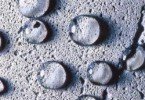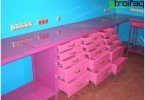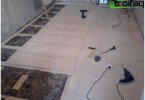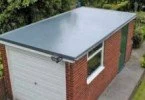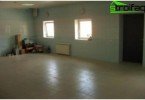Garage door insulation
A good garage should be moderately warm and always dry – this is an axiom that guarantees a long life and excellent “well-being” of the car in any weather, the safety of tools and other things stored in the car. Every owner of a capital brick or stone garage without stationary heating is well aware that dampness and cold are its main enemies, which can only be overcome by carefully insulating the walls, ceiling and gates. At the same time, quality insulation garage door, through which precious heat escapes and pernicious cold and moisture penetrate, is the main condition for a normal microclimate in the automobile monastery. There are several ways to solve this problem, from which everyone can choose for themselves the best in cost and execution.
Content
- Functions of garage doors and their types
- Automatic gates – a reliable barrier
- Self-insulation of garage doors
- Insulation for garage doors
- Classic thermal insulation materials
- Modern thermal insulation materials
Functions of garage doors and their types
In order not to create problems for the owner, sound garage doors must meet the following conditions:
- Simple and convenient entry and exit. That is, the width of the opening should provide a clearance of about 30 cm on each side of the entering car, and a sufficient height for passenger vehicles with a luggage carrier – 1.8-2 m, for freight – 2.5 m.
- Strength and burglar resistance. The condition is especially true for freestanding garages. Gates made of galvanized steel 2-5 mm thick, reinforced with armored plates for internal locks and overhead locks for external pads, will reliably protect against vandals. Wooden gates are suitable as a temporary economy option for secure garages only.
- Insulation from adverse atmospheric effects. Fastening the garage door to the frame using vertical locks and the use of a gasket will provide them with a snug fit, securely hold the doors, prevent possible skewing and completely protect the room from wind and precipitation.
How convenient the owner will use them daily depends on the design of the garage door.
In modern garages, the following types of gates are installed:
- Swing. The cheapest version of a two-leaf garage door requiring vigilant control over the entry area.
- Retractable. The design is similar to a sliding wardrobe door: when opening the door leaf moves to the side.
- Lifting and swiveling. When opening, the direct door leaf rises vertically to the ceiling of the garage and require a certain free space in the entrance area.
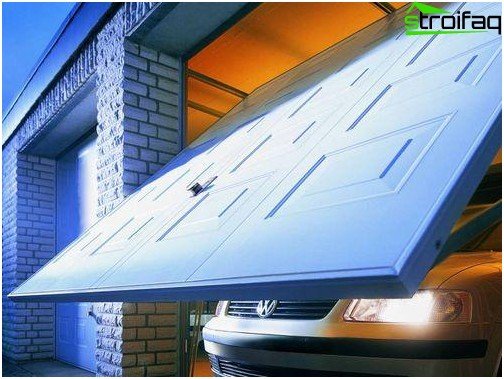
Lift-up garage door
- Sectional. In contrast to the lifting-and-turning leaf of a sectional door, it consists of several sections, which are refracted in the corners and vertically lifted to the ceiling by a system of profiles and springs, significantly saving the entrance area space.
- Roller. The design is a reinforced version of the roller shutter. When opened, the door leaf consisting of polymer-coated aluminum plates folds into a compact box above the garage entrance.
Automatic gates – a reliable barrier
The most modern, reliable and effective way to combat the heat loss of the garage, the penetration of moisture and even vandals into it is to install custom-made automatic gates of any design you like. The participation of the garage owner in this case is limited only to the transfer to the manufacturer of the exact dimensions of the entrance opening and payment of the order. The developers of the automatic garage door design have foreseen possible problems and provided the product with better properties.
- high strength and burglar resistance;
- thermal insulation;
- soundproofing;
- moisture resistance.
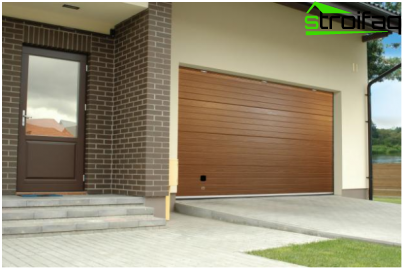
Automatic gates – an effective way to deal with the heat loss of the garage, the penetration of moisture and even vandals into it
Automatic garage doors are made of specially designed multilayer panels, in which insulation – polyurethane foam is laid between two metal plates. The tightness of the structure is ensured by a rubber seal placed around the perimeter, and special rubber is used that is resistant to temperature extremes, moisture and aggressive chemicals. A reliable system of hinges and brackets has been developed for fastening. The remote control system for opening / closing automatic gates increases the convenience of their operation. The only design flaw is the high cost..
Self-insulation of garage doors
If you still cannot afford to install automatic gates, then you will have to solve the problem of how to insulate the gates to the garage yourself. To get started, equip the gate with a compact front door, which saves you from having to wide open the entire opening even on those days when you do not plan to leave, but come to the garage to work or just visit your four-wheeled friend. An additional entrance does not completely solve the heat loss problem of the garage, but minimizes them if in winter you prefer not to use the machine and only occasionally come to the garage.
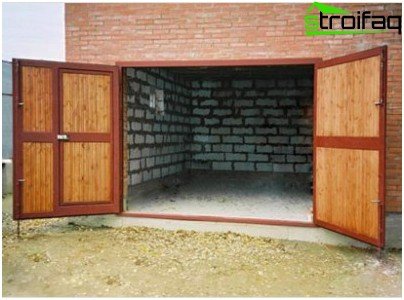
Additional compact entrance to the garage will reduce heat loss
Garage door insulation
A good garage should be moderately warm and always dry – this is an axiom that guarantees a long life and excellent “well-being” of the car in any weather, the safety of tools and other things stored in the car. Every owner of a capital brick or stone garage without stationary heating is well aware that dampness and cold are its main enemies, which can only be overcome by carefully insulating the walls, ceiling and gates. At the same time, quality insulation garage door, through which precious heat escapes and pernicious cold and moisture penetrate, is the main condition for a normal microclimate in the automobile monastery. There are several ways to solve this problem, from which everyone can choose for themselves the best in cost and execution.
Content
- Functions of garage doors and their types
- Automatic gates – a reliable barrier
- Self-insulation of garage doors
- Insulation for garage doors
- Classic thermal insulation materials
- Modern thermal insulation materials
Functions of garage doors and their types
In order not to create problems for the owner, sound garage doors must meet the following conditions:
- Simple and convenient entry and exit. That is, the width of the opening should provide a clearance of about 30 cm on each side of the entering car, and a sufficient height for passenger vehicles with a luggage carrier – 1.8-2 m, for freight – 2.5 m.
- Strength and burglar resistance. The condition is especially true for freestanding garages. Gates made of galvanized steel 2-5 mm thick, reinforced with armored plates for internal locks and overhead locks for external pads, will reliably protect against vandals. Wooden gates are suitable as a temporary economy option for secure garages only.
- Insulation from adverse atmospheric effects. Fastening the garage door to the frame using vertical locks and the use of a gasket will provide them with a snug fit, securely hold the doors, prevent possible skewing and completely protect the room from wind and precipitation.
How convenient the owner will use them daily depends on the design of the garage door.
In modern garages, the following types of gates are installed:
- Swing. The cheapest version of a two-leaf garage door requiring vigilant control over the entry area.
- Retractable. The design is similar to a sliding wardrobe door: when opening the door leaf moves to the side.
- Lifting and swiveling. When opening, the direct door leaf rises vertically to the ceiling of the garage and require a certain free space in the entrance area.

Lift-up garage door
- Sectional. In contrast to the lifting-and-turning leaf of a sectional door, it consists of several sections, which are refracted in the corners and vertically lifted to the ceiling by a system of profiles and springs, significantly saving the entrance area space.
- Roller. The design is a reinforced version of the roller shutter. When opened, the door leaf consisting of polymer-coated aluminum plates folds into a compact box above the garage entrance.
Automatic gates – a reliable barrier
The most modern, reliable and effective way to combat the heat loss of the garage, the penetration of moisture and even vandals into it is to install custom-made automatic gates of any design you like. The participation of the garage owner in this case is limited only to the transfer to the manufacturer of the exact dimensions of the entrance opening and payment of the order. The developers of the automatic garage door design have foreseen possible problems and provided the product with better properties.
- high strength and burglar resistance;
- thermal insulation;
- soundproofing;
- moisture resistance.

Automatic gates – an effective way to deal with the heat loss of the garage, the penetration of moisture and even vandals into it
Automatic garage doors are made of specially designed multilayer panels, in which insulation – polyurethane foam is laid between two metal plates. The tightness of the structure is ensured by a rubber seal placed around the perimeter, and special rubber is used that is resistant to temperature extremes, moisture and aggressive chemicals. A reliable system of hinges and brackets has been developed for fastening. The remote control system for opening / closing automatic gates increases the convenience of their operation. The only design flaw is the high cost..
Self-insulation of garage doors
If you still cannot afford to install automatic gates, then you will have to solve the problem of how to insulate the gates to the garage yourself. To get started, equip the gate with a compact front door, which saves you from having to wide open the entire opening even on those days when you do not plan to leave, but come to the garage to work or just visit your four-wheeled friend. An additional entrance does not completely solve the heat loss problem of the garage, but minimizes them if in winter you prefer not to use the machine and only occasionally come to the garage.

Additional compact entrance to the garage will reduce heat loss
When using the car every day without comprehensive heat insulation of the gates and careful sealing of cracks, you can not do. To do this, a lath made of wooden beams is mounted on the inner surface of the metal sheet of the garage doors in the same way as is done when warming the walls and ceiling of the garage. For the reliability of the construction, the battens are fixed to the door leaf on liquid nails and metal screws, and also fastened together with glue.
Important: It is recommended to install a metal crate on a wooden door, and on the metal door, on the contrary, a wooden crate: this technique provides sufficient structural strength and at the same time protects the metal from condensation – it is accepted by wood.
A layer of heat-insulating material is laid in the openings of the crate in such a way that a gap of 5-10 mm is maintained between the door leaf and the heat insulation. If glass wool is used as thermal insulation, it should be protected with a layer of waterproofing, for example, a polymer film.
Having laid a layer of thermal insulation, the structure is covered with galvanized iron or other finishing material. If you prefer galvanizing, the sheet of metal should be attached to the wooden frame with metal screws with a pitch of not more than 100 mm, otherwise the coating may bend under the load of its own weight. All joints should be treated around the perimeter with silicone sealant. In conclusion, a heat-insulating tape made of frost-resistant rubber is laid around the perimeter of the gate leaves, as well as in the places of their attachment to the frame, and a special tape sealant – vinyl threshold is glued to seal the lower edge.

Having laid a layer of insulation, the crate is sheathed with finishing material
How effective the door depends on the choice of thermal insulation material protect the garage from cold and damp.
Insulation for garage doors
As a heat insulator, you can use classic materials – mineral wool, fiberglass, polystyrene, as well as new heaters, which recently appeared on the building materials market. It should be noted that the modern construction industry has practically abandoned glass wool: this insulation material is fire hazardous, environmentally unfavorable and difficult to install. Nevertheless, the market offers a wide selection of heaters, which can conditionally be divided into classic and modern.
Classic thermal insulation materials
This group of traditional heaters includes well-known mineral wool and polystyrene..
Traditional mineral wool
This material is obtained during the processing of metallurgical slag or from basalt rocks, and is produced in the form of plates or in rolls. Mineral wool is not only non-flammable, but also a reliable obstacle to the spread of flame, which is very important for a garage where a spark can occur at any time. The lack of material is increased hygroscopicity, which reduces the thermal insulation ability. When laying mineral wool as a heater, it is necessary to provide a protective layer from steam and moisture, as well as an air gap. You can also use a perforated film to protect against moisture, eliminating the need for clearance..
Foam with flame retardants
The cheapest and easiest to use, and therefore the most popular classic insulation. If until recently this material was classified as fire hazardous, the addition of antiprene allowed the foam to go into the class of self-extinguishing materials. It is easy to install, does not need protection against vapors and moisture, and is resistant to fungi and mold. When ignited, the foam does not emit toxic substances, and its combustion products are the same as when burning wood.
Modern thermal insulation materials
This is a group of modern almost exotic “new products”, characterized by durability, high quality and ease of application. They are not very common yet, but some representatives – polyurethane foam, penoizol and liquid insulation Astratek – are very interesting and confidently win the sympathy of consumers.
Polyurethane foam – a new word
Foam insulation with a special spray is applied to the surface in an even layer and quickly hardens, forming a durable hard foam coating. A thin layer of polyurethane foam almost does not increase the thickness of the processed surface, and its thermal insulation properties are an order of magnitude higher compared to classic heaters. The service life of the material is designed for 70 years, but the disadvantages so far are the high price, due to the fact that only a team of specialists with special equipment can apply it.
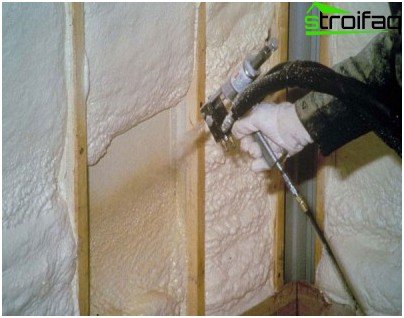
A thin layer of polyurethane foam almost does not increase the thickness of the processed surface, and its thermal insulation properties are an order of magnitude higher compared to classic heaters.
Penoizol – reliable thermal insulation
A modified version of the classic polystyrene foam with antiprene liquid consistency. The insulation is very quickly and simply applied from the cylinder to any surface, including into the voids of the garage door crate, filling the entire volume and not forming cracks and seams when solidifying. The service life of penoizol is designed for 40 years, it is waterproof, does not burn and is endowed with the best properties of classic heaters, delighting consumers with a price that is 1.5 times cheaper than ordinary polystyrene.
Liquid heater Astratek
Liquid material resembling ordinary paint is applied to the insulated surface with a paint roller or brush.
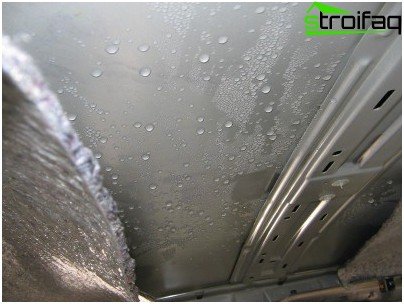
Liquid insulation Astratek looks like paint, but its thermal insulation ability is 50 times higher than mineral wool
The heat-insulating ability of Astratek insulation applied with a layer 1 mm thick is equivalent to the heat resistance of a layer of mineral wool 50 mm thick. One liter of liquid heat insulator is enough to process 2 sq.m. flat metal surface of garage door.
Regardless of which heat-insulating material you prefer, having warmed the garage door securely, you will forget about dampness, mold, fungus and tile or plaster falling off the walls for a long time, and your car will worthily meet more than one spring without the slightest signs of rust.


